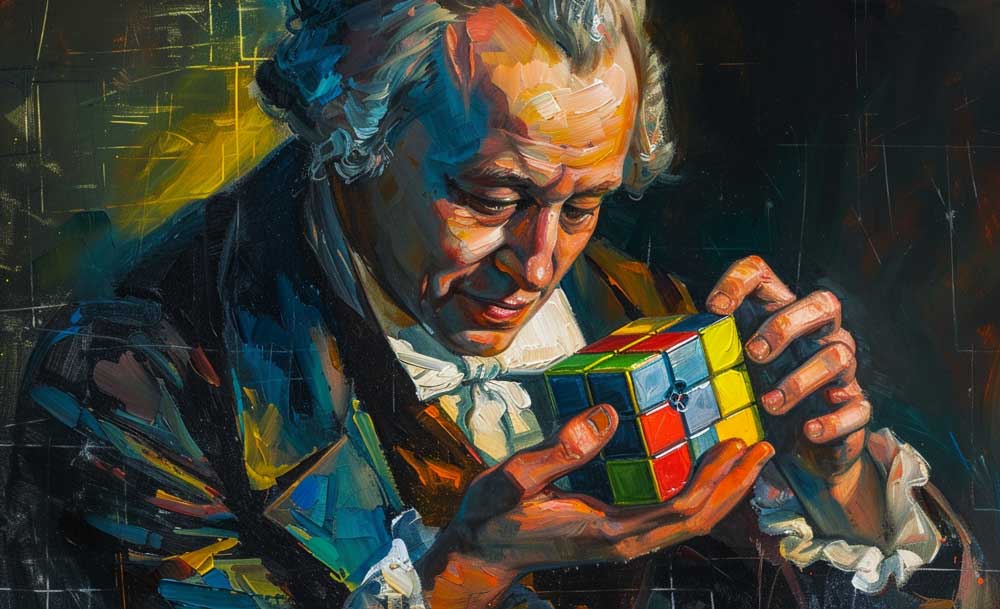
Kant's Thing-in-Itself: The Reality Behind the Curtain
|
|
Time to read 4 min
|
|
Time to read 4 min
What is Kant's "Thing-in-Itself" and why can't we ever truly know it?
How does Kant's concept of perception relate to our everyday experiences?
Why does the "Thing-in-Itself" still matter in modern philosophical discussions?
Picture this: You're at a party, chatting with friends about philosophy and the perception of reality (as one does). Suddenly, someone drops the question, "What if what we perceive is not the true reality?"
Enter Immanuel Kant, the philosophical maestro, with his captivating concept of the "Thing-in-Itself." Kant proposed that there exists a reality beyond human perception, an ultimate truth hidden behind the veil of our senses. This elusive reality is called the "Thing-in-Itself," or as the Germans say, "Ding an sich."
Let's break it down to bite-sized nuggets of understanding, like philosophy tapas. Imagine you're trying to enjoy a slice of pizza in a dark room. You can taste the flavors, feel the crunch, and savor the cheesiness, but you can't actually see the pizza itself. The pizza, in this case, is the "Thing-in-Itself." It exists independently of your perception, beyond what your senses can directly grasp.
Kant argued that our perception is like a filter, altering and shaping reality to fit into our limited human understanding. It's like the way we filter our Instagram photos, swapping out the dull colors for vibrant hues, but with a philosophical twist. The "Thing-in-Itself" represents the unfiltered, unadulterated reality that exists beyond our perception.
But here's the kicker: Kant asserted that we can never truly know the "Thing-in-Itself." It remains forever beyond the reach of our senses and understanding. It's like those tantalizingly elusive fashion trends you can never quite catch up to. You see others rocking the voguish styles, but it always slips away when you try to grasp it yourself. The "Thing-in-Itself" shares a similar mysterious quality.
Think of it this way: your brain is like a translator that converts the raw data of reality into something you can comprehend. But in that translation process, something always gets lost. The original, untranslated "Thing-in-Itself" remains hidden behind the scenes.
Kant introduced two fancy terms to help us understand this concept:
This distinction is crucial! The phenomenon is what we deal with daily – the world as filtered through our human experience. The noumenon (the Thing-in-Itself) remains tantalizingly out of reach.
So, if we can never truly know the "Thing-in-Itself," why bother discussing it at all? Well, it's precisely this enigmatic nature that ignites our philosophical curiosity. As humans, we're driven to explore the limits of knowledge and push the boundaries of what we can comprehend. The "Thing-in-Itself" serves as a reminder that there will always be mysteries to unravel and questions to ponder, which keeps the flame of intellectual curiosity burning bright in our hearts.
Kant's concept has influenced countless philosophers since, from Hegel to Schopenhauer (who had quite a lot to say about the Thing-in-Itself). Even modern discussions about virtual reality, simulation theory, and the nature of consciousness often circle back to Kant's fundamental insight: what we perceive may not be all there is.
You might be thinking, "Great, but how does this apply to my actual life?" Well, next time you're arguing with someone who seems to be experiencing a completely different reality than you are, remember the Thing-in-Itself. We're all interpreting the same underlying reality, but through different perceptual filters shaped by our experiences, culture, and biology.
Now imagine someone saying, "The tree exists in and of itself, as does the concept of existence itself, which further emphasizes the metaphysical essence of the universe itself." The joke with the misattributed quote from Kant teases the tendency to overuse the term "itself" in philosophical discussions, making it sound like a never-ending loop of profundity.
But don't let the fancy jargon fool you – at its core, Kant's Thing-in-Itself is a humble acknowledgment of human limitations and a tribute to the mysterious nature of reality that continues to fascinate us more than two centuries after he first proposed it.
So the next time someone asks you about the "Thing-in-Itself" at a party, you'll have something interesting to say – even if neither of you can ever truly know it!
Reality exists beyond our perception (the "Thing-in-Itself")
Our senses filter reality, limiting what we can truly know
The Thing-in-Itself remains forever unknowable to humans
This concept influenced philosophy and modern consciousness debates
Recognizing perceptual limitations helps understand differing viewpoints
You liked this blog post and don't want to miss any new articles? Receive a weekly update with the best philosophy memes on the internet for free and directly by email. On top of that, you will receive a 10% discount voucher for your first order.
Your cart is currently empty.
